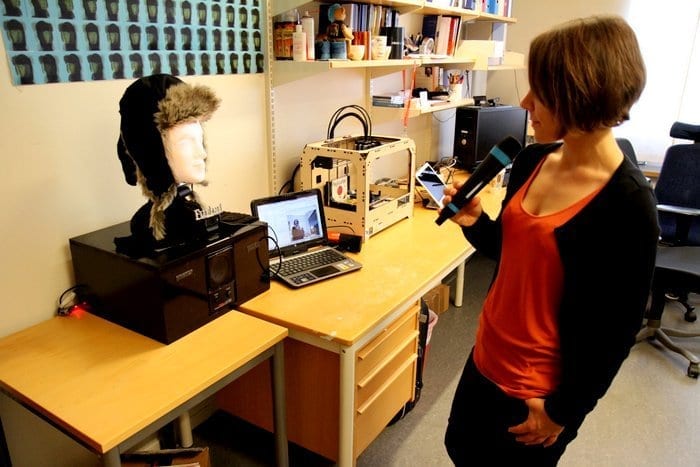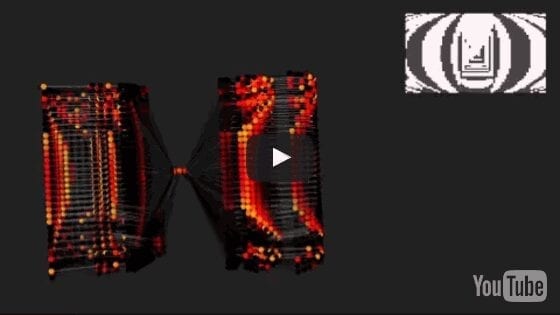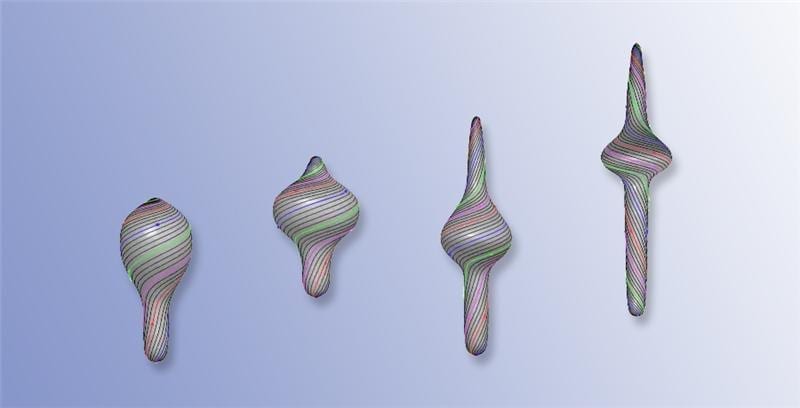
Human interaction with robots is about to get a little more personal. Meet the face of tomorrow’s interactive technology.
An increasingly important – and sometimes frustrating – part of daily life is dealing with so-called “user interfaces”. Whether it’s a smartphone or an airport check-in system, the user’s ability to get what they want out of the machine relies on their own adaptability to unfamiliar interfaces.
But what if you could simply talk to a machine the way you talk to a human being? And what if the machine could also ask you questions, or even address two different people at once?
These kinds of interactive abilities are being developed at KTH Royal Institute of Technology with the help of an award-winning robotic head that takes its name from the fur hat it wears.
With a computer-generated, animated face that is rear-projected on a 3D mask, Furhat is actually a platform for testing various interactive technologies, such as speech synthesis, speech recognition and eye-tracking. The robot can conduct conversations with multiple people, turning its head and looking each person straight in the eye, while moving its animated lips in synch with its words.
Samer Al Moubayed, one of the KTH researchers behind the development of Furhat, says the project represents the third generation of spoken dialogue systems that has been in development at KTH’s Department for Speech, Music and Hearing during the last 15 years.
Interest in the robot extends far beyond its home at KTH’s Stockholm campus. Furhat won an outstanding demonstration award at the ICMI conference in Los Angeles in 2012, and has been featured at robotics conventions in the U.K., France and Portugal. In addition, Al Moubayed received the Christian Benoit Award, a cash prize of EUR 7,500 awarded to promote promising research in the field of speech communication. Furhat also was named runner up for the international Robotdalen Innovation Award in 2013.
The Furhat team aims to develop its technology for commercial use, with the help of funding from Sweden’s Vinnova, a government agency that supports innovation projects.The team behind the development of Furhat also includes: Jonas Beskow, Joakim Gustafson, and Gabriel Skantze.
“Furhat is becoming a popular research platform for scientists around the world who study human interaction with machines,” Al Moubayed says. “It’s very simple, it’s potentially very cheap to make, and people want to use it in their own research areas.”
Furhat also has attracted attention from researchers at Microsoft and Disney. “They have been following the development of Furhat for a long time,” says Al Moubayed, who returned last week from a two-week visit to the U.S., where he presented the hardware and software behind Furhat at Microsoft’s and Disney’s research labs.
Al Moubayed says that Furhat has potential as an interactive user interface for a variety of applications. In schools, it could be used to conduct knowledge games with children. In assisted living centres, it could share information and chat with people.
Perched on a stand atop a bureau in Al Moubayed’s office, Furhat greets a visitor and asks their name. It then addresses Al Moubayed, and after a couple more questions, asks if the visitor has any questions for Furhat. During a pause in the exchange, the robot offers to tell a joke.
Part of what sets Furhat apart from other interactive robots is its ability to make not only conversation, but eye contact – an important element of communication.
The Latest on: Social robot
- Annoying ‘I’m not a robot’ captcha puzzles are getting HARDER – and experts reveal whyon April 27, 2024 at 1:28 pm
TECH experts have revealed the reason why annoying “I’m not a robot” captcha puzzles are getting harder. Internet users are often presented with the challenging dilemmas in order ...
- Students and faculty upset over AI Robot 'Sophia' giving commencement speech; university offers solutionon April 26, 2024 at 3:55 pm
"I'm going to be sitting on stage with the robot and I'm going to be asking 'Sophia' questions. Kind of about the future and the future students step into as they close that chapter of their college ...
- 5 things to know for April 26: Trump trials, University protests, Harvey Weinstein, TikTok ban, Starlineron April 26, 2024 at 3:59 am
A multi-day storm threat is set to impact millions of people in the central US through the weekend. Forecasts show parts of Texas, Missouri and Iowa are in the direct pathway of multiple rounds of ...
- Sanctuary’s new humanoid robot learns faster and costs lesson April 25, 2024 at 12:42 pm
Sanctuary AI often isn’t mentioned in the same breath as humanoid robotics firms like Boston Dynamics, Agility, Figure and 1X, but the Canadian company ...
- Ohio company hawks fire-breathing robot dog that can torch anything in its pathon April 25, 2024 at 12:07 pm
Ohio-based company Throwflame has created a robotic dog named the Thermonator that is capable of emitting 30-foot jets of fire.
- AI robot will give commencement speech at Upstate NY collegeon April 25, 2024 at 7:00 am
An artificial intelligence robot will give the commencement address at an Upstate New York college next month.
- People, Not Design Features, Drive Social Interactions for Robots, Finds Cornell University Studyon April 24, 2024 at 11:19 pm
It takes a village to nurture social robots.Researchers who develop social robots – ones that people interact with – focus too much on design features and not enough on sociological factors, like ...
- A.I. robot to give D’Youville commencement speechon April 24, 2024 at 11:44 am
BUFFALO, N.Y. (WIVB) — As students get ready to step into the future, D’Youville University is giving them an extra taste of tomorrow with its commencement speaker — an artificial intelligence (A.I.) ...
- 'The Wild Robot' Will Lumber into Theaters a Week Later Than Plannedon April 24, 2024 at 7:19 am
The Wild Robot, the next film by DreamWorks Animation, will now debut in theaters on September 27, a week later than originally planned.
- People, not design features, make a robot socialon April 22, 2024 at 8:24 am
It takes a village to nurture social robots. Researchers who develop social robots—ones that people interact with—focus too much on design features and not enough on sociological factors, like ...
via Bing News
The Latest on: Interactive robots
- Innovation Meets Creativityon April 27, 2024 at 1:37 pm
Artificial intelligence, robots, glass blowing, virtual reality, and performing arts were just a sampling of what thousands of visitors experienced at the 2024 Imagine RIT: Creativity and Innovation ...
- University Of New South Wales- Introducing Robots to Baby Care: Exploring the Future of Parentingon April 26, 2024 at 11:15 pm
More and more children are growing up with robots at home, but their impact on early learning and development is still largely unknown and unregulated.Technology has a profound impact on children.From ...
- BADMAD ROBOTS Announces Listing on Epic Games Store and Steam, Teams Up with Immutable Xon April 25, 2024 at 10:15 am
Singapore, April 25, 2024 (GLOBE NEWSWIRE) -- BADMAD ROBOTS, a team-based multiplayer shooter game, announced its official listing on Epic Games Store and Steam, two of the most prominent gaming ...
- Best Evil Robot You Can Buy: Robosen's Megatron Auto-Transforms via Voice Commandson April 25, 2024 at 9:17 am
The iconic Transformers villain comes to life in a self-converting robot that turns into a tank. It's a killer toy.
- Industrial robot makers gear up for global expansionon April 24, 2024 at 5:13 pm
Its load-carrying robots have achieved international performance standards at lower costs while providing quality interactive coordination services. "As a result, many domestic NEV manufacturers have ...
- Chinese Robot Code Source Lawsuit : Settlement Reachedon April 24, 2024 at 11:49 am
A long-standing legal battle involving accusations of copied robot toy source code between Pittsburgh-based Digital Dream Labs Inc. (DDL) and Chinese company Living Technology (Shenzhen) Co. has ...
- Korean robot startup aims to transform human walkingon April 23, 2024 at 11:31 pm
South Korean robotics startup WIRobotics aims to transform the walking experience via its award-winning wearable robot WIM, made lighter and more convenient for everyday use, the company's chief said ...
- Robots helping integrate kids at Turkey Run Elementary Schoolon April 23, 2024 at 1:41 pm
MARSHALL, IND. - A social skills class at Turkey Run Elementary School welcomed a new student earlier this year.
- Robot Dreams - Official Traileron April 23, 2024 at 9:46 am
Watch the trailer for Robot Dreams, an animated film from BLANCANIEVES director, Pablo Berger. Dog lives in Manhattan and he’s tired of being alone. One day he decides to build himself a robot, a ...
- The 6 best self-emptying robot vacuums for no-effort cleaning in 2024on April 19, 2024 at 2:00 am
UPDATE: Apr. 19, 2024, 5:00 a.m. EDT Roborock, Ecovacs, Eufy, and Samsung debuted new mopping robot vacuums at CES 2024. We're in the process of getting our hands on them for testing and will ...
via Bing News










